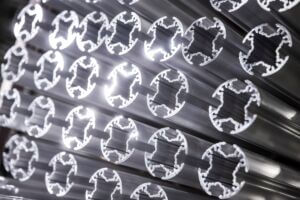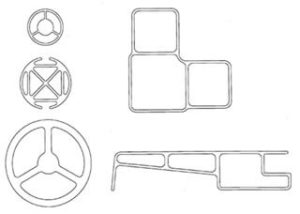Strength vs. weight vs. cost is an important comparison, as all play a key role in aluminum extrusion.

As you look at an aluminum extruded part from a cost standpoint, the alloy 6063 extruded in a solid shape is going to be the most cost-effective way to approach an aluminum extruded part.
On the other hand, a variation of aluminum alloys 6063 or 6060 (with somewhat lower mechanical properties) allows for more intricate extrusion profiles with slightly better heat transfer, making these alloys a viable alternative for heat sink profiles. However, they do not always give you the best performance regarding weight vs. strength. This factor often drives the application to a different alloy.
Certainly, with the 6000 series alloys there are several options available to increase the mechanical properties over 6063. However, every step we take, up the ladder of mechanical properties, causes us to lose some extrudability of the alloy. In addition to and parallel with that, it also has a negative effect on the extruded finish, which can have an impact on the aesthetic nature of a product.
Alloy Properties and Extrudability
Two common options to increase properties within the 6000 series alloy would be 6005 or 6061. Listed below are the mechanical properties of each alloy in their highest temper designation available. You will see a significant increase in the mechanical properties.
The extrudability table (Exhibit 1), which has an inverse curve to mechanical properties, shows the decreases in the speed at which the product can be extruded and has a negative impact on the cost. As we move up the mechanical properties, it also has somewhat of a bearing on our ability to produce a thin wall lighter weight extrusion. With the 6063 alloy, we could extrude down to a wall thickness of .025″. With 6061, we could extrude to a minimum of .035″-.040″ thickness, depending on profile characteristics and the extrusion press size. The alloy also has an impact on the complexity of the shape to be extruded.
When light weight and high strength are the goals, keep in mind the profile design of the extrusion itself. See the examples below of extruded shapes where center webs have been added as a load point of the extrusion, or the extrusion is designed to have a profile shape to take on the higher stress of that certain area (Exhibit 2).
Know Which Alloy to Choose
Partnering with our customers, we have had many opportunities to work through these issues of weight vs. strength, as many product designers are facing similar problems when deciding on the right alloy for their product application needs.
We also have worked with customers to develop special alloys that can give increased properties beyond the 6061. We have seen properties in excess of 30% greater than 6061 T6, however there are some significant drawbacks, including required minimum volumes.
At Alexandria Industries, we are here to help our customers work through these issues with one-on-one design assistance to ensure products are designed for manufacturability. To learn more about aluminum extrusion and the benefits it brings to product design, we offer a no-cost, non-commercialized, aluminum extrusion seminar. The 2 to 3-hour seminar will take you through the entire extrusion process from start to finish in much greater detail. We can design the seminar to address your specific needs and will host it at your location or ours.
Aluminum Alloys 6000 Series:
- Magnesium and Silicon
- Most popular extrusion alloy class
- Good extrudability
- Good strength
- Good corrosion resistance
- Good machinability
- Good weldability
- Good formability
- Heat treatable
6063
- Most popular alloy in the 6000 series
- Used in a broad range of applications requiring both strength and appearance
6060
- Similar in characteristics to 6063 (mechanical properties)
- Designed to achieve maximum extrudability
- Excess silicon alloy (reduction in the magnesium portion of Mg2Si)
6463
- Similar in characteristics to 6063
- Designed to accept bright dip anodizing
6061
- Combines high mechanical properties/strength with good corrosion resistance
6005(A)
- Similar in characteristics to 6061 (mechanical properties)
- In many cases can replace 6061 with better extrudability and surface appearance
- Excess silicon alloy (reduction in the magnesium portion of the Mg2Si)
EXHIBIT 1
| Alloy | Surface Quality | Extrudability | Typical RA |
| 6060 | Very good | Excellent | 63* |
| 6063 | Very good | Excellent | 63* |
| 6005A | Good | Good | 90* |
| 6061 | Fair | Good | 125* |
| 6463 | Very good | Excellent | 32* |
*Dependent on shape and surface area
Temper Designation
T4 Solution heat treated and naturally aged (controlled to a maximum specification)
T5/T6 Solution heat treated, cooled from an elevated temperature and artificially aged (controlled to a minimum specification)
EXHIBIT 2

Call us if you have questions and would like more information on choosing the right alloy for your product application.
